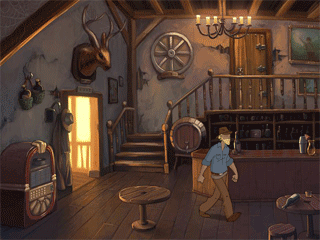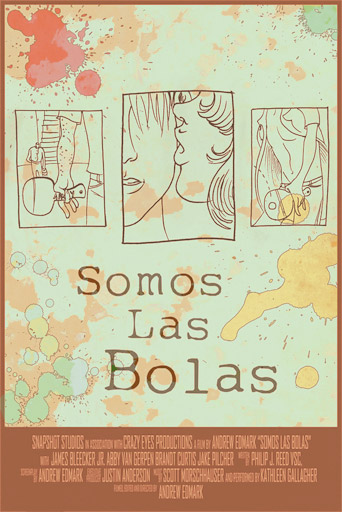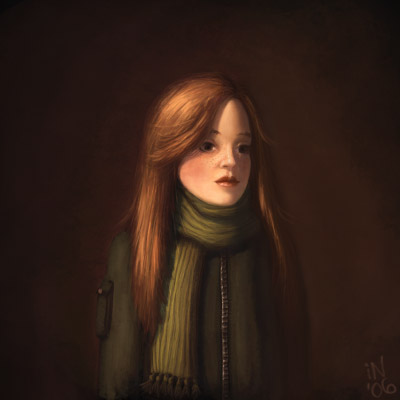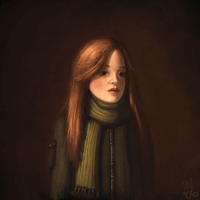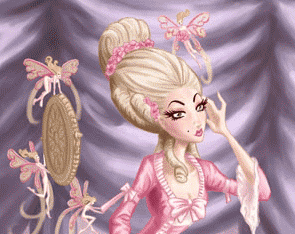I've encouraged others in the past to show some work in progress pictures, since they're fun to look at, and provide different approaches to painting/drawing, as well as function as sort of pseudo tutorials. I haven't really seen any yet, so here's a small attempt at getting the ball rolling:
Thumbnail stage:
In this stage, I keep the size of the sketches loose and small, about 4 cm wide (bit more than an inch). This allows me to try things quickly, and prohibits me from going into detail, since you can't really make anything out anyway. The focus is on composition and the general feel of it.
I usually do about 15 of these, and if I think some design has some promise, I add values to see how it works out. Some things look great as outlines, but turns out less so when the lighting is added, and vice versa, so even if a design doesn't look all that promising in outlines, I might give it a go with values, as in this case.

(click pic for full size)
The point of this stage is basically to create as many versions of the painting as is needed, until you find one with promise, but with the advantage of only requiring one or two minutes each. In theory, you could skip this stage n go straight to a full blown thing with details, but few have the patience, time n stomach to spend hours on each version, only to discard all but one.
-
As for this one, I'll most likely find a new design, as the centre angle on the house, and general design n composition isn't what I was looking for; was thinking a more antique looking house/workshop in the outskirts of a town. The kind of lighting, with small areas of intense light will probably prevail though, so at least that part is more or less set, though I'll have to test it against the new design.
-
I'm gonna be posting pretty much everything related to the creation, so as to show all the crappy stuff as well, n not just the gold nuggets. To avoid clogging up the thread n eating up bandwidth, I'm going to resort to small thumbnails of everything but the current sketch.
(Btw, the sketch in the upper right has nothing to do with the background; it's only there because I tend to fill up empty spaces with sketches of the kind, and there would usually be a couple more. They're a nice distraction from the thumbnail sketching and livens up the document. I hate sterile spaces.)
-
Some more thumbnails, design sketches, n a font test, for the sign above the large window (yep, that's supposed to be a sign)

-
Post thumbnail stage (crappy title, I know)
After I've decided on a thumbnail, I blow it up in size, to at least the double of the intended resolution (think this landed on about 1900x 1300).
(I wasn't very satisfied with this thumbnail in its current state, but I felt compelled to start refining to be sure to finish it in time, and I can hopefully fix it later on, though this is a risky approach. Btw, the reason I picked this view was that it allows us to read the sign, while still not looking at that part of the house straight on).

The point of this huge size is to allow me to paint with rough strokes in the new original size while still appearing detailed when zoomed out to the intended end resolution.
-
Now I simply start refining things. Since I'm not content with the composition yet, this is rather risky, but I'm gonna let it turn out in whatever way it does. At least it'll be a house design sketch.

I still focus on the composition n values, though I do some colour tests, by simply adding a layer n setting the blending mode (the small textbox in the upper left of the layer window) to colour, which means that only the colours of the layer will be applied to the layers below, not the values.
A quick colour test.
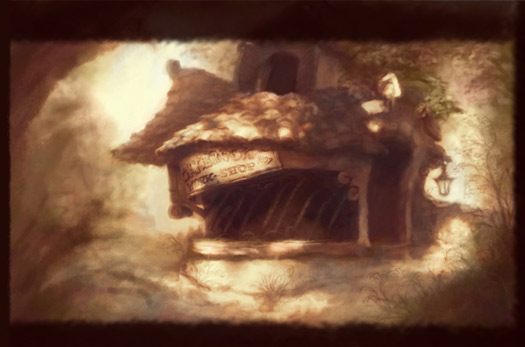
As the colours are roughly applied, it gets this technicolour look, (which I really like), but I'm going to refine it further at a later point for more of a disney's Robin Hood look.
-
-
With the additional time, I should have some time to make this into a semi decent tutorial.
So, to continue from the latest version, it's on to:
Fixes
This is a stage I reallly hope to avoid, but due to crappy pre planning I'm here.
When I did the thumbnails, I talked about focusing on composition, which to some must've seemed like bs, since I mostly did outlines of the house, and I can only say that I agree, and the composition has suffered for it.
The problem I still have is that composition is very flat. Luckily this isn't all that difficult to fix, especially since I'm working on layers.
So this is the current version (same as above):

To simplify, it looks something like this:
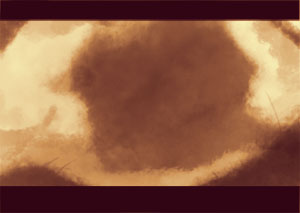
The thought behind this composition is firstly, place the house at a good position, in this case close to the golden ratio, both horizontally n vertically. The golden ration is something like 1.6, which in practise means that it's a bit off center (at number 6 in the pic below):

The house is placed closer towards five since the small wall to the right of it argueably feels like part of the house, which would offset the center much more to the right.
Then it's a matter of the foreground, which is the real culprit in this case. In the current state it does the job of framing the scene and dragging the eye towards the center.
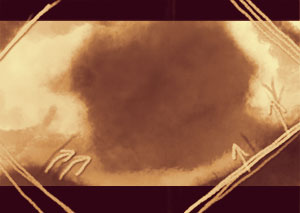
I tend to try to frame it so it creates a sort of rotated square, which should create more dynamic lines than vertical n horizontal lines.
The plants all points towards the house, as to drag the eyes back into the center, so they can be lead around the image. This might seem a bit too constructed, but the nice things with plants is that they grow towards sunny areas. In this case the house area seems to receive the most light (at this time of the day anyway), so there would be a reason for them to grow in this fashion.
Anyway, to the problem with the foreground: in this state what it doesn't do is to create depth by intersecting with other objects. As illustrated below, they're all small isolated islands, detached from each other:

The easiest remedy is simply to reposition the foreground objects, and as in this example, also adding an object (a mailbox):

Now pretty much everything is concealing some other area:
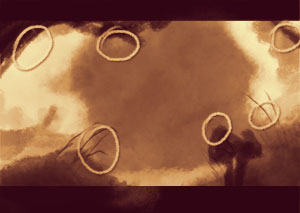
The problem with too many covering objects, and especially if they're bushes n similar is that you can get a sort of stalker view, the impression that the camera is spying on the subject.
I placed these objects in a zig zag order depth wise, which the eye seems to enjoy to follow, plus it makes the intersections more clear.

I think this composition is a bit crowded, so I'm probably going to go with some sparser version
-
More foreground added and some perspective stuff
In this one I've added some much needed overlapping (rough) foreground, as well as corrected the wooden frame on the window to look like it's curved around the section, which was very unclear in the previous versions. The distinction between the ground n the house wall is still unclear though, which I think I'll deal with by added more grass n stuff at the bottom of the wall.
It's still a bit flat, with the distance between the house n the foreground being very close, and I'm going to look into some closer foreground objects n objects in general to add some life to the environment.
The stairs were added basically to create a more interesting varied look.
The foreground foliage is in much need of some value variation n detail, but I want to settle their silhouette first.

-
Since there aren't really any other entries atm, I'm going to keep the current pics in their larger size for now.
-
Hope this might prove interesting to someone.
(I'm going to be out of town as of thursday evening, so I probably won't be able to update this pseudo tutorial until sunday).
Edit: A small comment: one of the benefits of working from small loose thumbnails, which you then increase in size, is that you'll have tons of artifacts, which should really be treated as gold. It's awfully hard to construct randomness, and it's easy to loose it once you start refining, things. When I start refining, I make sure to boost the artifacts of the thumbnail, but try to touch them as little as possible, since even when you boost them by strokes, you start designing. Course, in more stylized styles, this isn't an issue.
Thumbnail stage:
In this stage, I keep the size of the sketches loose and small, about 4 cm wide (bit more than an inch). This allows me to try things quickly, and prohibits me from going into detail, since you can't really make anything out anyway. The focus is on composition and the general feel of it.
I usually do about 15 of these, and if I think some design has some promise, I add values to see how it works out. Some things look great as outlines, but turns out less so when the lighting is added, and vice versa, so even if a design doesn't look all that promising in outlines, I might give it a go with values, as in this case.

(click pic for full size)
The point of this stage is basically to create as many versions of the painting as is needed, until you find one with promise, but with the advantage of only requiring one or two minutes each. In theory, you could skip this stage n go straight to a full blown thing with details, but few have the patience, time n stomach to spend hours on each version, only to discard all but one.
-
As for this one, I'll most likely find a new design, as the centre angle on the house, and general design n composition isn't what I was looking for; was thinking a more antique looking house/workshop in the outskirts of a town. The kind of lighting, with small areas of intense light will probably prevail though, so at least that part is more or less set, though I'll have to test it against the new design.
-
I'm gonna be posting pretty much everything related to the creation, so as to show all the crappy stuff as well, n not just the gold nuggets. To avoid clogging up the thread n eating up bandwidth, I'm going to resort to small thumbnails of everything but the current sketch.
(Btw, the sketch in the upper right has nothing to do with the background; it's only there because I tend to fill up empty spaces with sketches of the kind, and there would usually be a couple more. They're a nice distraction from the thumbnail sketching and livens up the document. I hate sterile spaces.)
-
Some more thumbnails, design sketches, n a font test, for the sign above the large window (yep, that's supposed to be a sign)

-
Post thumbnail stage (crappy title, I know)
After I've decided on a thumbnail, I blow it up in size, to at least the double of the intended resolution (think this landed on about 1900x 1300).
(I wasn't very satisfied with this thumbnail in its current state, but I felt compelled to start refining to be sure to finish it in time, and I can hopefully fix it later on, though this is a risky approach. Btw, the reason I picked this view was that it allows us to read the sign, while still not looking at that part of the house straight on).

The point of this huge size is to allow me to paint with rough strokes in the new original size while still appearing detailed when zoomed out to the intended end resolution.
-
Now I simply start refining things. Since I'm not content with the composition yet, this is rather risky, but I'm gonna let it turn out in whatever way it does. At least it'll be a house design sketch.

I still focus on the composition n values, though I do some colour tests, by simply adding a layer n setting the blending mode (the small textbox in the upper left of the layer window) to colour, which means that only the colours of the layer will be applied to the layers below, not the values.
A quick colour test.

As the colours are roughly applied, it gets this technicolour look, (which I really like), but I'm going to refine it further at a later point for more of a disney's Robin Hood look.
-
-
With the additional time, I should have some time to make this into a semi decent tutorial.
So, to continue from the latest version, it's on to:
Fixes
This is a stage I reallly hope to avoid, but due to crappy pre planning I'm here.
When I did the thumbnails, I talked about focusing on composition, which to some must've seemed like bs, since I mostly did outlines of the house, and I can only say that I agree, and the composition has suffered for it.
The problem I still have is that composition is very flat. Luckily this isn't all that difficult to fix, especially since I'm working on layers.
So this is the current version (same as above):

To simplify, it looks something like this:

The thought behind this composition is firstly, place the house at a good position, in this case close to the golden ratio, both horizontally n vertically. The golden ration is something like 1.6, which in practise means that it's a bit off center (at number 6 in the pic below):

The house is placed closer towards five since the small wall to the right of it argueably feels like part of the house, which would offset the center much more to the right.
Then it's a matter of the foreground, which is the real culprit in this case. In the current state it does the job of framing the scene and dragging the eye towards the center.

I tend to try to frame it so it creates a sort of rotated square, which should create more dynamic lines than vertical n horizontal lines.
The plants all points towards the house, as to drag the eyes back into the center, so they can be lead around the image. This might seem a bit too constructed, but the nice things with plants is that they grow towards sunny areas. In this case the house area seems to receive the most light (at this time of the day anyway), so there would be a reason for them to grow in this fashion.
Anyway, to the problem with the foreground: in this state what it doesn't do is to create depth by intersecting with other objects. As illustrated below, they're all small isolated islands, detached from each other:

The easiest remedy is simply to reposition the foreground objects, and as in this example, also adding an object (a mailbox):

Now pretty much everything is concealing some other area:

The problem with too many covering objects, and especially if they're bushes n similar is that you can get a sort of stalker view, the impression that the camera is spying on the subject.
I placed these objects in a zig zag order depth wise, which the eye seems to enjoy to follow, plus it makes the intersections more clear.

I think this composition is a bit crowded, so I'm probably going to go with some sparser version
-
More foreground added and some perspective stuff
In this one I've added some much needed overlapping (rough) foreground, as well as corrected the wooden frame on the window to look like it's curved around the section, which was very unclear in the previous versions. The distinction between the ground n the house wall is still unclear though, which I think I'll deal with by added more grass n stuff at the bottom of the wall.
It's still a bit flat, with the distance between the house n the foreground being very close, and I'm going to look into some closer foreground objects n objects in general to add some life to the environment.
The stairs were added basically to create a more interesting varied look.
The foreground foliage is in much need of some value variation n detail, but I want to settle their silhouette first.

-
Since there aren't really any other entries atm, I'm going to keep the current pics in their larger size for now.
-
Hope this might prove interesting to someone.
(I'm going to be out of town as of thursday evening, so I probably won't be able to update this pseudo tutorial until sunday).
Edit: A small comment: one of the benefits of working from small loose thumbnails, which you then increase in size, is that you'll have tons of artifacts, which should really be treated as gold. It's awfully hard to construct randomness, and it's easy to loose it once you start refining, things. When I start refining, I make sure to boost the artifacts of the thumbnail, but try to touch them as little as possible, since even when you boost them by strokes, you start designing. Course, in more stylized styles, this isn't an issue.


